英语语法---代词的用法
- 格式:doc
- 大小:55.00 KB
- 文档页数:10
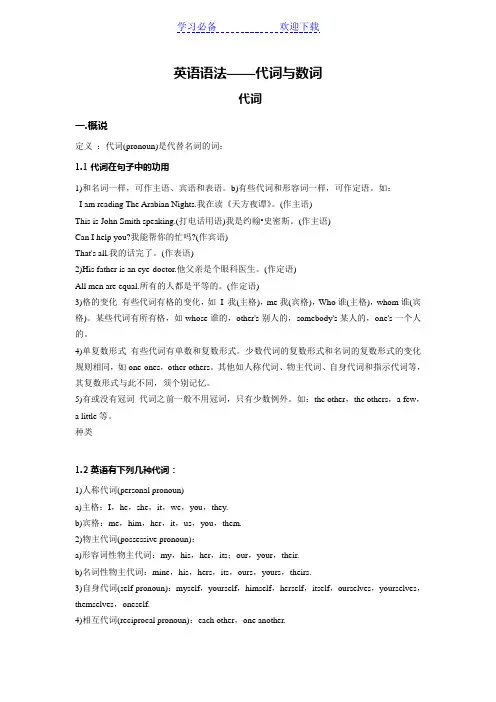
英语语法——代词与数词代词一.概说定义:代词(pronoun)是代替名词的词:1.1代词在句子中的功用1)和名词一样,可作主语、宾语和表语。
b)有些代词和形容词一样,可作定语。
如:I am reading The Arabian Nights.我在读《天方夜谭》。
(作主语)This is John Smith speaking.(打电话用语)我是约翰•史密斯。
(作主语)Can I help you?我能帮你的忙吗?(作宾语)That's all.我的话完了。
(作表语)2)His father is an eye-doctor.他父亲是个眼科医生。
(作定语)All men are equal.所有的人都是平等的。
(作定语)3)格的变化有些代词有格的变化,如I 我(主格),me我(宾格),Who谁(主格),whom谁(宾格)。
某些代词有所有格,如whose谁的,other's别人的,somebody's某人的,one's一个人的。
4)单复数形式有些代词有单数和复数形式。
少数代词的复数形式和名词的复数形式的变化规则相同,如one-ones,other-others。
其他如人称代词、物主代词、自身代词和指示代词等,其复数形式与此不同,须个别记忆。
5)有或没有冠词代词之前一般不用冠词,只有少数例外。
如:the other,the others,a few,a little等。
种类1.2英语有下列几种代词:1)人称代词(personal pronoun)a)主格:I,he,she,it,we,you,they.b)宾格:me,him,her,it,us,you,them.2)物主代词(possessive pronoun):a)形容词性物主代词:my,his,her,its;our,your,their.b)名词性物主代词:mine,his,hers,its,ours,yours,theirs.3)自身代词(self-pronoun):myself,yourself,himself,herself,itself,ourselves,yourselves,themselves,oneself.4)相互代词(reciprocal pronoun):each other,one another.5)指示代词(demonstrative pronoun):this,that,these,those,such,same.6)疑问代词(interrogative pronoun):who,whom,whose,which,what.7)关系代词(relative pronoun):who,whom,whose,which,that.8)不定代词(indefinite pronoun):some,something,somebody,someone,any,anything,anybody,anyone,no,nothing,nobody,no one,every,everything,everybody,everyone,each,much,many,little,a little,few,a few,other,another,all,none,one,both,either,neither.二.人称代词概说表示"我',、"你"、"他"、"我们"、"你们"、"他们"等的词,叫做人称代词。
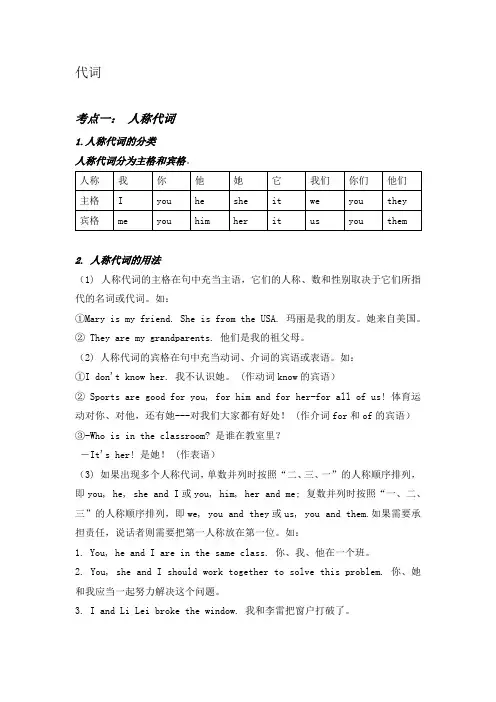
代词考点一:人称代词1.人称代词的分类人称代词分为主格和宾格。
2. 人称代词的用法(1) 人称代词的主格在句中充当主语,它们的人称、数和性别取决于它们所指代的名词或代词。
如:①Mary is my friend. She is from the USA. 玛丽是我的朋友。
她来自美国。
② They are my grandparents. 他们是我的祖父母。
(2) 人称代词的宾格在句中充当动词、介词的宾语或表语。
如:①I don't know her. 我不认识她。
(作动词know的宾语)② Sports are good for you, for him and for her-for all of us! 体育运动对你、对他,还有她---对我们大家都有好处! (作介词for和of的宾语)③-Who is in the classroom? 是谁在教室里?-It's her! 是她! (作表语)(3) 如果出现多个人称代词,单数并列时按照“二、三、一”的人称顺序排列,即you, he, she and I或you, him, her and me; 复数并列时按照“一、二、三”的人称顺序排列,即we, you and they或us, you and them.如果需要承担责任,说话者则需要把第一人称放在第一位。
如:1. You, he and I are in the same class. 你、我、他在一个班。
2. You, she and I should work together to solve this problem. 你、她和我应当一起努力解决这个问题。
3. I and Li Lei broke the window. 我和李雷把窗户打破了。
考点二:物主代词1. 物主代词的分类物主代词分为形容词性物主代词和名词性物主代词。
2. 物主代词的用法(1) 形容词性物主代词用来作定语,修饰名词。

英语语法——代词与数词代词一.概说定义:代词(pronoun)是代替名词的词:1.1代词在句子中的功用1)和名词一样,可作主语、宾语和表语。
b)有些代词和形容词一样,可作定语。
如:I am reading The Arabian Nights.我在读《天方夜谭》。
(作主语)This is John Smith speaking.(打电话用语)我是约翰•史密斯。
(作主语)Can I help you?我能帮你的忙吗?(作宾语)That's all.我的话完了。
(作表语)2)His father is an eye-doctor.他父亲是个眼科医生。
(作定语)All men are equal.所有的人都是平等的。
(作定语)3)格的变化有些代词有格的变化,如I 我(主格),me我(宾格),Who谁(主格),whom谁(宾格)。
某些代词有所有格,如whose谁的,other's别人的,somebody's某人的,one's一个人的。
4)单复数形式有些代词有单数和复数形式。
少数代词的复数形式和名词的复数形式的变化规则相同,如one-ones,other-others。
其他如人称代词、物主代词、自身代词和指示代词等,其复数形式与此不同,须个别记忆。
5)有或没有冠词代词之前一般不用冠词,只有少数例外。
如:the other,the others,a few,a little等。
种类1.2英语有下列几种代词:1)人称代词(personal pronoun)a)主格:I,he,she,it,we,you,they.b)宾格:me,him,her,it,us,you,them.2)物主代词(possessive pronoun):a)形容词性物主代词:my,his,her,its;our,your,their.b)名词性物主代词:mine,his,hers,its,ours,yours,theirs.3)自身代词(self-pronoun):myself,yourself,himself,herself,itself,ourselves,yourselves,themselves,oneself.4)相互代词(reciprocal pronoun):each other,one another.5)指示代词(demonstrative pronoun):this,that,these,those,such,same.6)疑问代词(interrogative pronoun):who,whom,whose,which,what.7)关系代词(relative pronoun):who,whom,whose,which,that.8)不定代词(indefinite pronoun):some,something,somebody,someone,any,anything,anybody,anyone,no,nothing,nobody,no one,every,everything,everybody,everyone,each,much,many,little,a little,few,a few,other,another,all,none,one,both,either,neither.二.人称代词概说表示"我',、"你"、"他"、"我们"、"你们"、"他们"等的词,叫做人称代词。
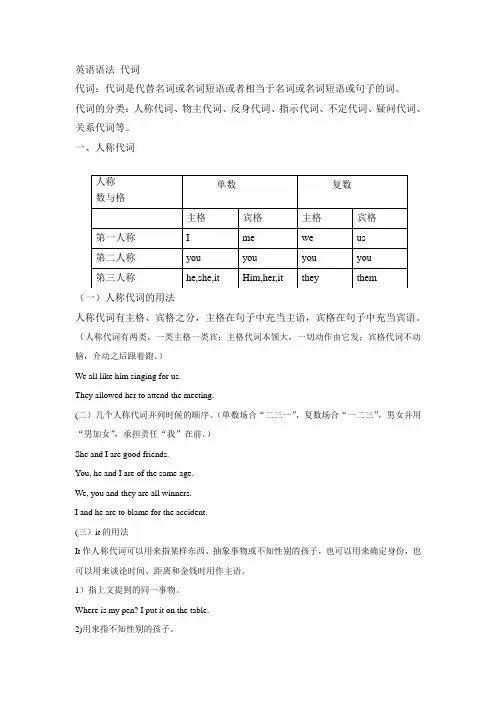
英语语法 代词代词:代词是代替名词或名词短语或者相当于名词或名词短语或句子的词。
代词的分类:人称代词、物主代词、反身代词、指示代词、不定代词、疑问代词、关系代词等。
一、人称代词(一)人称代词的用法人称代词有主格、宾格之分,主格在句子中充当主语,宾格在句子中充当宾语。
(人称代词有两类,一类主格一类宾;主格代词本领大,一切动作由它发;宾格代词不动脑,介动之后跟着跑。
) We all like him singing for us. They allowed her to attend the meeting.(二)几个人称代词并列时候的顺序。
(单数场合“二三一”,复数场合“一二三”,男女并用“男加女”,承担责任“我”在前。
) She and I are good friends. You, he and I are of the same age. We, you and they are all winners. I and he are to blame for the accident. (三)it 的用法It 作人称代词可以用来指某样东西、抽象事物或不知性别的孩子,也可以用来确定身份,也可以用来谈论时间、距离和金钱时用作主语。
1)指上文提到的同一事物。
Where is my pen? I put it on the table. 2)用来指不知性别的孩子。
人称 数与格 单数 复数主格 宾格 主格 宾格 第一人称 I me we us 第二人称 you you you you 第三人称 he,she,itHim,her,ittheythemShe is pregnant. I hope it will be a girl.3)用来确定身份。
Someone is knocking at the door. I don’t know who it is.It’s your mother on the phone.4)谈论时间、距离、天气时作主语。
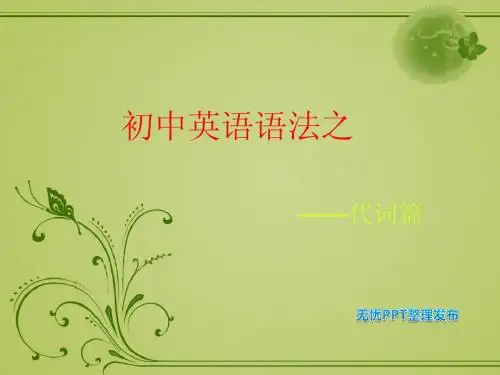

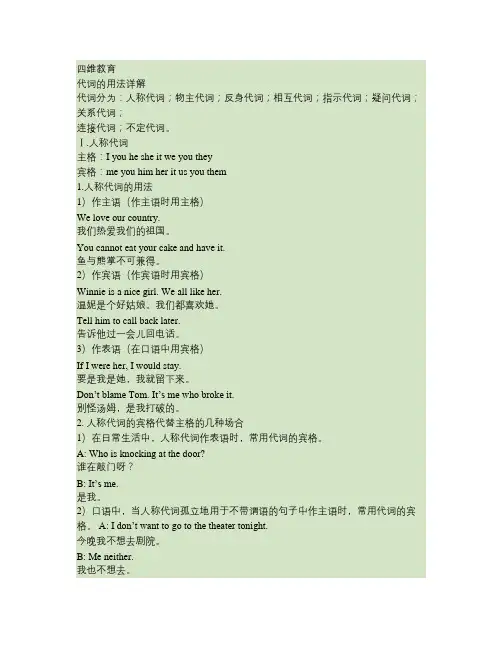
四维教育代词的用法详解代词分为:人称代词;物主代词;反身代词;相互代词;指示代词;疑问代词;关系代词;连接代词;不定代词。
Ⅰ.人称代词主格:I you he she it we you they宾格:me you him her it us you them1.人称代词的用法1)作主语(作主语时用主格)We love our country.我们热爱我们的祖国。
You cannot eat your cake and have it.鱼与熊掌不可兼得。
2)作宾语(作宾语时用宾格)Winnie is a nice girl. We all like her.温妮是个好姑娘。
我们都喜欢她。
Tell him to call back later.告诉他过一会儿回电话。
3)作表语(在口语中用宾格)If I were her, I would stay.要是我是她,我就留下来。
Don’t blame Tom. It’s me who broke it.别怪汤姆,是我打破的。
2. 人称代词的宾格代替主格的几种场合1)在日常生活中,人称代词作表语时,常用代词的宾格。
A: Who is knocking at the door?谁在敲门呀?B: It’s me.是我。
2)口语中,当人称代词孤立地用于不带谓语的句子中作主语时,常用代词的宾格。
A: I don’t want to go to the theater tonight.今晚我不想去剧院。
B: Me neither.我也不想去。
A: I’d like to stay here for another week.我想在这里再呆一周。
B: Me too.我也是。
3)在带as 和than 的比较级后面,许多场合下用代词的宾格。
She knows me as well as him.她像了解他一样了解我。
He is taller than me.他比我高。
4)口语中,当人称代词用于带有强烈感情色彩的句子中作主语且其后不带宾语时,多用代词的宾格。

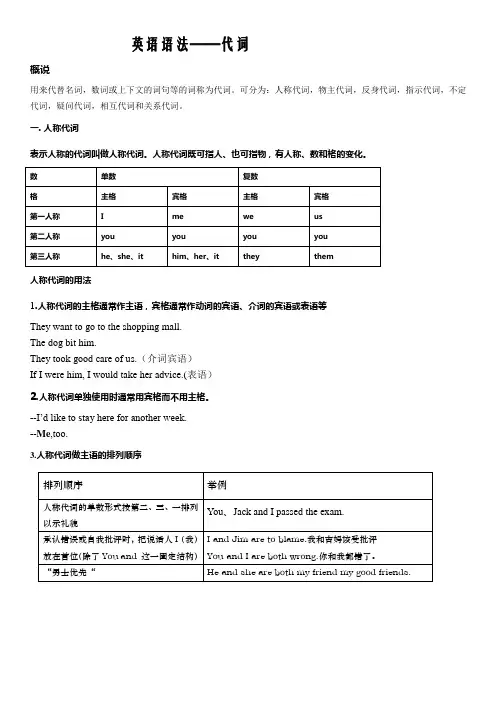
英语语法——代词概说用来代替名词,数词或上下文的词句等的词称为代词。
可分为:人称代词,物主代词,反身代词,指示代词,不定代词,疑问代词,相互代词和关系代词。
一.人称代词表示人称的代词叫做人称代词。
人称代词既可指人、也可指物,有人称、数和格的变化。
数单数复数格主格宾格主格宾格第一人称I me we us第二人称you you you you第三人称he、she、it him、her、it they them人称代词的用法1.人称代词的主格通常作主语,宾格通常作动词的宾语、介词的宾语或表语等They want to go to the shopping mall.The dog bit him.They took good care of us.(介词宾语)If I were him, I would take her advice.(表语)2.人称代词单独使用时通常用宾格而不用主格。
--I’d like to stay here for another week.--Me,too.3.人称代词做主语的排列顺序排列顺序举例人称代词的单数形式按第二、三、一排列以示礼貌You、Jack and I passed the exam.承认错误或自我批评时,把说话人I(我)放在首位(除了You and 这一固定结构)I and Jim are to blame.我和吉姆该受批评You and I are both wrong.你和我都错了。
“男士优先“He and she are both my friend my good friends.二.物主代词表示所有关系的代词叫做物主代词,分为形容词性物主代词和名词性物主代词。
数人称形容词性物主代词名词性物主代词单数第一人称my mine第二人称your yours第三人称his、her、its his、hers、its复数第一人称our ours 第二人称your yours 第三人称their theirs1.形容词性物主代词用法:可作定语相当于形容词I love my work in the hospital.2.名词性物主代词=形容词性物主代词+名词,可用作主语、宾语和表语Ours is a socialist country.I didn't borrow her dictionary. I borrowed his.Whose pencil is this?-It is hers.She is a friend of mine=She is a friend of my friends.三.反身代词表示主语发出的动作反射到施动者本身。
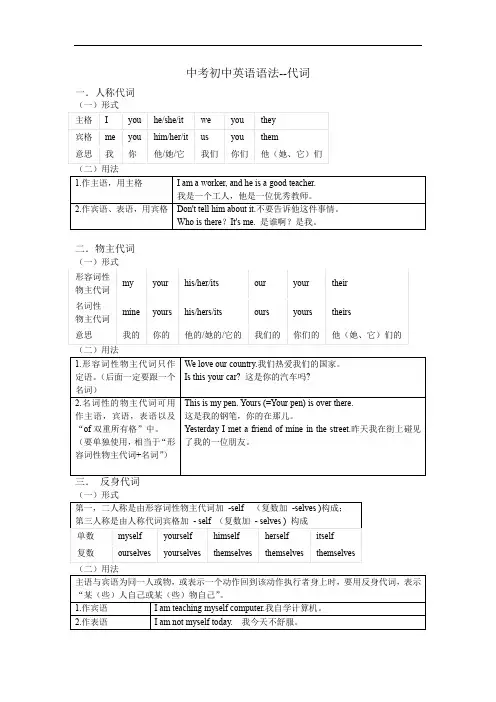
中考初中英语语法--代词一.人称代词(一)形式二.物主代词(一)形式(二)用法练一练一.写出代词形式二.用所给代词的适当形式填空1. That is not _________ kite. That kite is very small, but _________ is very big. ( I )2. The dress is _________. Give it to _________. ( she )3. Is this _________ watch? (you) No, it’s not _________ . ( I )4. _________ is my brother. ________ name is Jack. Look! Those stamps are _________. ( he )5. _________ dresses are red. (we) What colour are _________? ( you )6. Here are many dolls, which one is _________ ? ( she )7. I can find my toy, but where’s _________? ( you )8. Show _________ your kite, OK? (they)9. I have a beautiful cat. _________name is Mimi. These cakes are _________. ( it )10. Are these ________ tickets? No, ________ are not _________. ________ aren’t here. ( they )11. Shall _________ have a look at that classroom? That is _________ classroom. ( we )12. _________ is my aunt. Do you know _________ job? ( she )13. That is not _________ camera. _________is at home. ( he )14. Where are _________? I can’t find _________. Let’s call _________ parents. ( they )15. _________ don’t know her name. Would you please tell _________. ( we )16. So many dogs. Let’s count _________. ( they )17. I have a lovely brother. _________ is only 3. I like _________ very much. ( he )18. May I sit beside _________? ( you )19.The girl behind _________ is our friend. (she )20. They want a football . Give _______the green one, please. ( they )21.My skirt is better than_________. ( you)22.Mr. Smith is an old friend of_________ ( I).23. Mary, help _________to the bananas, please. ( you )24.They all enjoyed _________ at the party. ( they )25.Mr Wang teaches ______ maths and I teach ______computer.(I)参考答案:二.1.my;mine 2.hers; her 3.your;mine 4.He;His;his 5.Our;yours 6.hers 7.yours 8.them 9.Its ;its 10.their;they; theirs; Theirs 11. we; our 12.She;her 13.his; His 14.they;them;their 15.We;us 16.them 17.He;him 18.you 19.her 20.them 21.yours 22.mine 23.yourself 24. themselves25.me; myself一、英语阅读理解专项练习试卷1.阅读下列短文, 从每题所给的四个选项(A、B、C和D)中选出最佳选项。
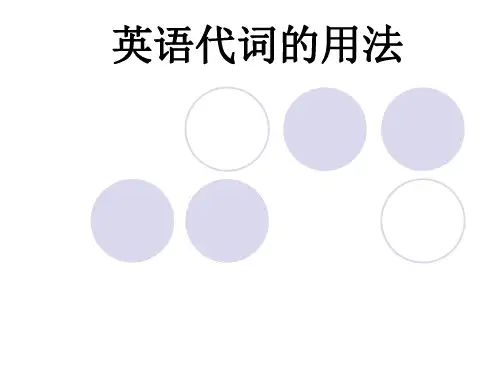
初中英语语法代词讲解Newly compiled on November 23, 2020初中英语语法代词代词:为了避免重复而用来代替其他词的词。
种类:1) 人称 2) 物主 3) 反身4) 指示 5)不定6) 疑问7) 相互代词:each other, one another互相,其所有格加-’s8) 关系代词:which, who,that,whom,whose等引导定语从句9) 连接代词:who, whom, whose, what, which, whatever, whichever, whoever, whomever10)替代词:one(单数), ones(复数)用于替代前面出现的同类事物。
但ones必须和形容词连用。
如果替代的名词时无形容词在前,则用some, any,而不用ones。
如:Have you bought any rulers Yes,I 've bought some.一、人称代词1.人称代词的形式2.人称代词的句法功能3.人称代词的排列顺序(单数231,复数123)当两个以上的人称代词一起作主语时,单数按二、三、一人称排列(即you, he / she, I);复数按一、二、三人称排列(即we, you, they)。
但是如果做错了事需要承担责任时,要把说话人(I)放在第一位。
如:It was I and John that made her angry. 是我和约翰惹她生气了。
二、物主代词1.物主代词的形式2.物主代词的基本用法3.物主代词的特殊用法在双重所有格中只能用名词性物主代词。
如:我的一个朋友a friend of mine ,她的一个同学 a classmate of hers , each brother of his.三、反身代词1.反身代词的形式反身代词又叫自身代词,表示动作返回到动作发出者本身。
2.反身代词的句法功能3.由反身代词构成的习惯用语①help oneself to 随便吃……②come to oneself 苏醒过来,醒悟,恢复知觉③dress oneself 自己穿衣服④say to oneself 自言自语⑤enjoy oneself 玩得开心⑥lose oneself in迷路于,全神贯注于…之中,消失于⑦teach oneself 自学⑧look after oneself ⑨by oneself 亲自learn……by oneself 自学…leave one by oneself 把某人单独留下hurt oneself 伤了自己make yourself/yourselves at home 不必拘束四、指示代词1. that 用来代替前面提到的不可数名词,those代替复数名词。
英语语法-代词用法代词是英语中的一类词汇,用来代替名词或名词短语。
代词的使用可以简化句子结构,使其更加简洁明了。
在英语语法中,代词有多种用法,下面将详细介绍代词的用法。
首先,代词可以用来指代一个名词。
例如,我们可以用主格代词来代替主语,如he、she、it等。
例如,原句是"I am going to the store",我们可以用代词"He"来代替主语"I",得到"He is going to the store"。
在这个例子中,代词"He"代替了名词"I",使句子更加简洁。
其次,代词也可以用来指代一个名词的所有格形式。
例如,我们可以用所有格代词来代替名词的所有格形式,如mine、yours、hers等。
例如,原句是"This is John's car",我们可以用代词"mine"来代替名词所有格形式"John's",得到"This car is mine"。
在这个例子中,代词"mine"代替了名词所有格形式"John's",使句子更加简洁。
此外,代词还可以用来指代一个名词的宾格形式。
例如,我们可以用宾格代词来代替名词的宾格形式,如me、you、him等。
例如,原句是"She gave the book to me",我们可以用代词"her"来代替宾格形式"me",得到"She gave the book to her"。
在这个例子中,代词"her"代替了名词宾格形式"me",使句子更加简洁。
还有一种常见的代词用法是反身代词。
代词的种类:主格、宾格略1.人称代词 (1)表示人以外的动物和东西it的用法 (2)指代child, baby等名词.(3)表示天气、时间、距离、环境等(4)用it作形式主语和宾语2. 物主代词:形容词性物主代词和名词性物主代词略。
注意:a, an, the和this, that, some等词后不能加物主代词。
构成法略3. 反身代词:常接反身代词的动词有dress, enjoy, express, help等by oneself 独立地She can do it all by herself介词+反身代词 for oneself 为自己He has a right to decide for himself of oneself 自动的Every day I awake of myself at 5:304. 相互代词: each other, one another.注意:each other多指两者之间的“相互”, one another多指三者以上的“相互”5. 指示代词:this, that, these, those注意:打电话中,this指我, that指你6. 疑问代词:who/whom, whose, what, which7. 关系代词:who, whose, whom, that, which不可数:much, a little等单数:one, either, each, other, every thing8. 不定代词可数 neither, another some body复数:both, a few, many, several any + oneno不可数:all, some, any, enough常用不定代词辨析:1. some和any:some一般用于肯定句中,表示“几个”“一些”,修饰可数或不可数名词I have some work to do todaya. some用于疑问句中,表示建议、请求Would you like some coffee with sugar?any一般用否定句和疑问句,表示“任何一些”“任何一个”They didn’t have any friends here.b any用于肯定句,表示“任何的”Come here with any friends.2. no, none ,no one和neithera. no是形容词,只能作定语,修饰不可数名词或可数名词There is no time left. Please hurry up!b. none只能独立使用,可指人或物,后可与of连接,谓语动词可用单数或复数形式None of us have/has that book.c. no one只能指人,不可与of连接,谓语动词只能用单数形式No one knows how he managed to get the ticketd. neither两者之间都不,表示全部否定,谓语只能用单数形式Neither of them knows Japanese.3. all和both, eithera. all指三者或三者以上的“都”b. both指两者的“都”c. either指两者中的“一个”注意:all, both, each作同位语时的位置两前:行为动词前,半系动词前三后:连系动词后,情态动词后,助动词后They are both fine, too.We both like English.They may both speak English4. every和 eachevery是形容词,修饰单数名词,指三个人或三个以上的人或物,后不可直接接ofeach可作形容词、代词。
代词相关语法知识详解什么叫代词?顾名思义,代词就是用来代替名词及起名词作用的短语或句子的词。
英语代词的用法不是很复杂,但其种类却比较多,如按它们的意义和用法可分为人称代词、物主代词、指示代词、相互代词、不定代词、疑问代词、连接代词、关系代词等八类。
一、人称代词1. 主格与宾格所谓人称代词,指的就是表示“你”“我”“他”等不同人称的代词。
人称代词不仅有单复数之分,而且根据它在句子中的不同作用还有主格和宾格之别。
主格:I, you, he, she, it, we, you, they宾格:me, you, him, her, it, us, you, them人称代词的主格就是指人称代词在句子中用作主语时所用的形式,而其宾格就是指它在句子中用作宾语时所采用的形式。
如:He loves me and I love him too. 他爱我,我也爱他。
汉语中的“他”和“我”不管在句子中用作主语还是宾语,形式上都没有变化。
但是,在英语中就不同了。
比如在上面这个句子中,he和I分别用于loves和love前用作主语,所以用了主格;而me和him则分别用于loves和love后用作宾语,所以用了宾格。
若人称代词用作表语,则既可用主格,也可用宾格,两者的区别是:在口语中或非正式文体中多用宾格,在正式文体中多用主格。
如:This is me and these are my friends. 这是我,这些是我的朋友。
类似地,在than, as 后的人称代词也具有以上特点,即在口语中或非正式文体中多用宾格,在正式文体中多用主格。
如:They are richer than we [us]. 他们比我们富有。
注意,若than, as 后的人称代词后跟有动词,则必须用主格。
如:I swim better than him.=I swim better than he does. 我游泳比他好。
另外,还有一点要特别注意,就是在口语中,当人称代词单独使用时,通常用宾格。
英语语法:代词的用法
代词是代替名词的词类。
大多数代词具有名词和形容词的功能。
英语中的
代词,按其意义、特征及在句中的作用分为:人称代词、物主代词、指示代
词、自身代词、相互代词、疑问代词、关系代词和不定代词八种。
下面就来跟
着小编一起学习英语语法:代词的用法吧。
一、人称代词是表示"我"、"你"、"他"、"她"、"它"、"我们"、"你们"、" 他们"的词。
人称代词有人称、数和格的变化,见下表:
例如:Heis my friend. 他是我的朋友。
It's me. 是我。
二、物主代词是表示所有关系的代词,也可叫做代词所有格。
物主代词分形容性物主代词和名词性物主代词两种,其人物和数的变化见下表。
代词定义代词(pronoun)是代替名词的词:代词在句子中的功用1)和名词一样,可作主语、宾语和表语。
2)有些代词和形容词一样,可作定语。
如:a) I am reading The Arabian Nights.我在读《天方夜谭》。
(作主语)This is John Smith speaking.(打电话用语)我是约翰·史密斯。
(作主语) Can I help you?我能帮你的忙吗?(作宾语)That's all.我的话完了。
(作表语)b)His father is an eye-doctor.他父亲是个眼科医生。
(作定语)All men are equal.所有的人都是平等的。
(作定语)3)格的变化有些代词有格的变化,如 I 我(主格),me我(宾格),Who谁(主格),whom谁(宾格)。
某些代词有所有格,如whose谁的,other's别人的,somebody's某人的,one's一个人的。
4)单复数形式有些代词有单数和复数形式。
少数代词的复数形式和名词的复数形式的变化规则相同,如one-ones,other-others。
其他如人称代词、物主代词、自身代词和指示代词等,其复数形式与此不同,须个别记忆。
5)有或没有冠词代词之前一般不用冠词,只有少数例外。
如:the other,the others,a few,a little等。
种类英语有下列几种代词:1)人称代词(personal pronoun)a)主格:I,he,she,it,we,you,they.b)宾格:me,him,her,it,us,you,them.2)物主代词(possessive pronoun):a)形容词性物主代词:my,his,her,its;our,your,their.b)名词性物主代词:mine,his,hers,its,ours,yours,theirs.3)自身代词(self-pronoun):myself,yourself,himself,herself,itself,ourselves,yourselves,themselves,oneself.4)相互代词(reciprocal pronoun):each other,one another.5)指示代词(demonstrative pronoun):this,that,these,those,such,same.6)疑问代词(interrogative pronoun):who,whom,whose,which,what.7)关系代词(relative pronoun):who,whom,whose,which,that.8)不定代词(indefinite pronoun):some,something,somebody,someone,any,anything,anybody,anyone,no,nothing,nobody,no one,every,everything,everybody,everyone,each,much,many,little,a little,few,a few,other,another,all,none,one,both,either,neither.人称代词概说表示"我',、"你"、"他"、"我们"、"你们"、"他们"等的词,叫做人称代词。
人称代词的用法1)人称代词主格的用法a)作主语I am a cook.(炊事员) We are cooks,You are a teacher.(教师) You are teachers.He is a barber.(理发员) The yare barbers.She is a nurse.(护士)The yare nurses.It is a cart.(大车) They are carts.b)作表语It's I .是我。
Oh,it's you. 噢,是你。
[注一]第一人称单数人称代词I (我)永远要大写。
(见上面例句)[注二]口语习惯上不说it's I (he, she等),而说It's me (him,her等)。
2)人称代词宾格的用法a)作及物动词的宾语The dog bit him.那只狗咬了他。
Our P. T. teacher taught us to swim yesterday.我们的体育老师昨天教我们游泳。
This is my new hat. Do you like it ?这是我的新帽子,你喜欢吗?b)作介词的宾语My brother often writes tome.我弟弟常给我写信。
They took good care of us.他们无微不至地照料我们。
3)人称代词的其他用法各人称代词除按照自身的人称、数和格使用外,还有下列一些特殊用法:a)报刊的编辑和文章的作者,在发表观点时,常用we代替I (同样用our 代替my)。
如:We believe that China will make still greater progress in shipbuilding.我们相信中国的造船业将会有更大的发展。
In our opinion this is the best film of the year.我们认为这是今年最好的影片。
b)用she来代替国家、城市、船舶、飞机以及动物等,以表示亲切和爱抚。
如:That's the picture of the Dongfeng; she is a 10,000 - ton class ocean - going freighter.那是万吨远洋货轮东风号的照片。
The dog waved his tail when he saw his master.那狗看见主人就摇尾巴。
c)北有时可用来代替小孩(child)和婴儿(baby)。
如:The child smiled when it saw its mother.小孩见到母亲就笑了。
d) they可用来代替一般的人,特别在"they say"中。
如:They say there's going to be another good harvest this year.人们说今年又是个丰收年。
物主代词概说表示所有关系的代词叫做物主代词,也可叫做代词所有格。
物主代词的用法1)形容词性物主代词用作定语I love my work in the hospital.我喜欢我在医院的工作。
How many students are there in his (her) class?他(她)班上有多少学生?There are many good teachers in our school.我们学校有许多好老师。
I saw a film lasts saturday. Its title was Guerrillas on the Plains.我上星期六看了一个电影,名叫《平原游击队》。
2)名词性物主代词用作主语、宾语和表语a)用作主语:Our room is on the first floor, and theirs is on the second 我们的房间在一层,他们的在二层。
Ours is a socialist country.我们的国家是社会主义国家。
b)用作宾语:I didn't borrow her dictionary. I borrowed his.我没有借她的字典,我借的是他的。
c)用作表语:Whose pencil is this?-It is hers.这是谁的铅笔?--是她的。
These tools are ours.这些工具是我们的。
[注]"of+名词性物主代词"和2.12的"of+名词所有格"的用法完全一样。
如:a friend of mine我的一个朋友(表示部分观念,意即我有不少朋友,他(她)是其中之一)this lovely child of yours你的这个可爱的孩子(有感情色彩)自身代词概说表示反射(指一个动作回射到该动作执行者本身)或强调(即用来加强名词或代词的语气)的代词叫做自身代词。
自身代词的用法1)在句中作宾语,表示动作回到动作执行者的本身。
如:Please help yourself to some lea.请自己用茶。
(作help的宾语)The girl is too young to look after herself.这女孩太小,还不能照顾自己。
(作look after的宾语)He was always ready to help others; he never thought of himself他总是帮助别人,从不想到自己。
(作thought of的宾语)2)在句中作名词或代词的同位语,用来加强名词或代词的语气,作"亲自"、"本人"解。
它在句中可置于名词、代词之后,也可置于句子末尾。
如:You yourself said so.你自己是这样说的。
The desk itself is not so heavy.书桌本身并不重。
I fixed the window myself.这窗户是我自己装的。
相互代词表示相互关系的代词叫做相互代词。
相互代词的用法1)作宾语。
如:Do you often see one another?你们彼此常见面吗?New and old students learn from each other.新老同学相互学习。
.John and Tom helped each other.约翰和汤姆相互帮助。
2)作定语时须用所有格。
如:We are interested in one another's work.我们关心彼此的工作。
The students corrected each other's mistakes in their homework.学生相互改作业中的错误。
Students cut each other's hair.同学们相互理发。
3)each和other有时可分开用。
如:Each tried to persuade the other to stay at home.两个人都彼此劝说对方留在家里。
指示代词概说表示"这个"、"那个"、"这些"、"那些"等指示概念的代词叫做指示代词。